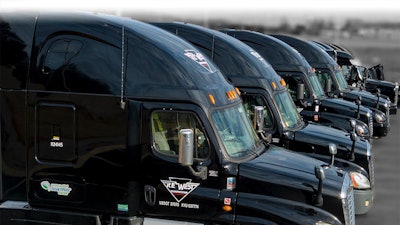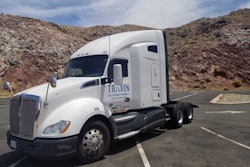 When looking to cut costs, especially during the ongoing COVID-19 pandemic, fleets can look at healthcare insurance as an area with alternatives that could save money while continuing to offer competitive benefits packages.
When looking to cut costs, especially during the ongoing COVID-19 pandemic, fleets can look at healthcare insurance as an area with alternatives that could save money while continuing to offer competitive benefits packages.Healthcare is typically the second or third largest budget item for most trucking companies, said Alex Dampf, president of Nashville-based health insurance brokerage Oakmont Benefits Group. And over the last 10-15 years, the cost of health insurance – including deductibles and other out-of-pocket costs for employees – has steadily climbed, he said.
Dave Chase, co-founder of the Health Rosetta blueprint for health benefits, said healthcare costs typically account for approximately 20% of all payroll expenses.
Those big annual expenses and climbing costs, especially in the midst of a pandemic, has fleets searching for alternatives to the traditional health insurance model.
Though employers and employees are conditioned to think about healthcare only in the terms of that traditional insurance model, Dampf says options like Health Rosetta can help motor carriers build insurance plans more specifically to their needs.
“The main thing with Health Rosetta is putting transparency back in healthcare,” Dampf said. “No one really knows what’s happening behind the scenes. The goal is to first bring that back to see exactly what’s going on. The goal is to make it simpler and provide the types of coverage they need by designing a plan to provide the highest level of value to the employee at a reasonable cost.”
Another alternate form of health insurance is the reference-based pricing (RBP) model, which determines a more reasonable cost for care based on the actual cost of procedures before .
“Our clients step away from the traditional PPO network and adopt metrics to pay claims,” said Steve Kelly, co-founder of CEO of RBP insurance provider ELAP Services. “The data is available publicly. Hospitals file exhaustive data reports every year that shows the cost of service. We pay the hospital or medical practitioner for services based on that. We identify the actual cost of the service and allow a fair margin above that cost and avoid wild fluctuations prevalent in the traditional PPO model.”
Health Rosetta’s Chase said he equates the health insurance industry to the ports business before today’s standard shipping container was mainstream. “My dad was in the ports business,” he said. “Over the course of his career, the standard shipping container got mainstreamed. You look at pictures of the ports before standard containers, it’s a mess. In a lot of ways, that’s how standard [healthcare] plans are – not connected and inefficient.”
With an RBP plan like those from ELAP, employers still have total discretion to design their plan to meet the needs of their employees. The biggest difference with the RBP model, Kelly said, is how insurance claims are paid.
“In reference-based pricing, employers and employees can go where they choose,” Kelly said. “If a provider won’t accept payments, the employer is left with a choice – either negotiate a single contract agreement for a single episode of care or find another site.”
Companies like Kelly’s ELAP Services work with their clients to negotiate in case a payment issue arises.
 Tennessee-based R.E. West switched to a non-traditional healthcare plan for its employees in 2019 and saved 15% on costs in the first year. (R.E. West photo | Facebook)
Tennessee-based R.E. West switched to a non-traditional healthcare plan for its employees in 2019 and saved 15% on costs in the first year. (R.E. West photo | Facebook)Fleets report benefits from alternative healthcare plans
Ashland City, Tennessee-based carrier R.E. West, with the help of Dampf and his firm, broke the mold of using a traditional insurance company that offers certain packages without many options.
“We had shared the increase with our employees and wanted to try to do better,” said Jenny West, CFO of R.E. West. “We’re in a very competitive market in trucking and feel there’s a competitive advantage [with our benefits] …You lose out on new hires because of your costs, and we felt there was a better way – we just hadn’t found it yet.”
Dampf said the Health Rosetta-style plan was the answer for R.E. West.
“They transitioned from fully insured to partially self-funded and eliminated the insurance company,” Dampf said. “We hired an independent, third-party administrator and hired an independent pharmacy benefits manager, so that we have more control over that supply chain. Really, sometimes there are a lot of hands in the cookie jar. You start removing some of those members from the supply chain that don’t add a value, and your cost comes significantly down.”
R.E. West, a 130-truck van and flatbed/heavy-haul fleet, switched to the new plan on Jan. 1, 2019, and had a 15% reduction in health insurance costs, saving around $102,000 that year, instead of a 25% increase that would have taken effect and put healthcare spend around $270,000, Dampf said.
“Trucking is a very low margin industry,” West said. “We’re always counting our pennies, so this has been very important for us. It adds up. We still have quality insurance but at a lower cost.”
West added that over the years with rising insurance costs, there wasn’t a lot of pushback from employees because they were “conditioned to expect it.”
One area of the company West has seen improvement since switching healthcare plans has been in driver recruiting. “Potential employees are recognizing the lower healthcare costs,” she said.
Dampf added that, while R.E. West is a medium-sized carrier, alternative health insurance plans can work for fleets of all sizes.
“I think most business owners think they can’t operate in this model without an insurance company or traditional model,” he said. “Size isn’t as big of an issue as they think it is. Whether they go this far down the road, or make small, incremental changes that can make a big difference to drivers and the bottom line without any real disruption.”
Classic Carriers, a 150-truck fleet out of Versailles, Ohio, switched to the RBP insurance model in 2016 after being faced with a 43% increase in premiums following a year with a high number of large claims, according to company president Jerold Richards. He added that, prior to that bad year in 2015, the company had also seen 10-15% increases each year in the previous three to four years.
“We were hearing dissatisfaction from our drivers, who were seeing increases every year,” Richards said. “We were also hopping around from one plan to the next every year to try to find the lowest cost.”
Richards said based on projections of if the company had stayed on a traditional health insurance plan with an estimated 7% annual increase since their switch in 2016 to the RBP model, Classic Carriers is about 35% below that projection on healthcare spend. He noted there have still been annual cost increases, but only at about 4.5%.
“The cost of healthcare has increased in the last five years, but we’ve stayed below the average of what the industry has experienced,” Richards said.
Richards added that those savings have allowed the company to reinvest in other parts of the business for wage increases, investment in new equipment and more.
The first step in moving toward an alternative health insurance plan is to work with a benefits broker, Chase said. “You really can’t get from here to there without working with the right person.” If the Health Rosetta plan is appealing, the company has a list of its accredited brokers here.
Kelly said one of the first things fleets should do is talk to their insurance brokers and a prospective provider and ask for references within the trucking industry who have been using the RBP concept for at least two years. “There’s no better way to test the idea than to talk to people who have done it,” he said.
 Classic Carriers switched to a reference-based pricing insurance model in 2016 and has saved approximately 35% on its healthcare spend since the switch based on cost projections with traditional insurance.
Classic Carriers switched to a reference-based pricing insurance model in 2016 and has saved approximately 35% on its healthcare spend since the switch based on cost projections with traditional insurance.The benefit to employees
For Classic Carriers, the switch to the RBP model required its employees to take more ownership of their insurance plans by planning ahead and asking questions about how much certain prescriptions or procedures would cost.
“In the past, we never asked how much these things would cost,” Richards said. “We all were used to insurance just paying the cost, you pay your co-pay or deductible and not worry about it. We had to educate our employees on how the system worked.”
In some cases, if an individual is overcharged based on what ELAP feels is a reasonable cost for the service, they will only pay what they feel is reasonable, Richards said. The service provider could then bill the employee the balance, which then requires the employee to reach out to ELAP to negotiate with the provider on the balance.
“The threat in RBP is the balance bill,” Kelly said. “We defend employees if necessary or negotiate a fair settlement if directed to do so.”
Richards added that other than employees being more proactive with their health, not much changed for employees after the switch to RBP. Co-pays and deductibles stayed the same, and one of the biggest benefits was seen with prescription drug costs. Through a program called Canarx, which works with government-licensed pharmacies in Canada, the United Kingdom and Australia, Classic Carriers employees can pay no co-pay for certain prescriptions.
Dampf said in R.E. West’s first year with its new plan, employees were offered three plans to choose from. “After the first year, they had such a big reduction in costs, we eliminated the two base plans, and all employees got the richest plan at the lowest plan’s cost from the previous year,” he said. “They either got a better plan at a lower cost or the same plan at a lower cost.”
West said she’s heard nothing but positive feedback from her employees – both drivers and office personnel – since the changes took effect nearly two years ago.
“People here appreciate what they have and have taken ownership,” she said. “They have a buy-in to how they operate with their tools. That’s a big deal. You preached those things in the past, but for whatever reason, it really resonates now, and they see a result from it.”
West said with the new plan, her employees can turn to apps on their phones to have access to just about everything involving their healthcare.
“We are mobile,” she said. “We all have handheld devices and are used to apps. Our drivers can turn to apps to guide them on really anything. If they’re on the road and need a prescription refilled or are sick and need to see someone, it’s how we operate. I think it’s a lot better.”
She added that many truck drivers don’t have primary care physicians at home, and with her employees taking more ownership, they’ve been able to learn “how to care for themselves with this and recognize what they need. It’s led to better care overall.”
She also noted that prescription drug coverage was one of the areas that needed the most help before the switch. “We were very unhappy with that.” Working with Dampf, R.E. West was able to choose coverage that has about 250 medications that employees are able to access for free.
According to Chase, the pharmacy benefit accounts for 20-25% of employer’s overall healthcare spend.











